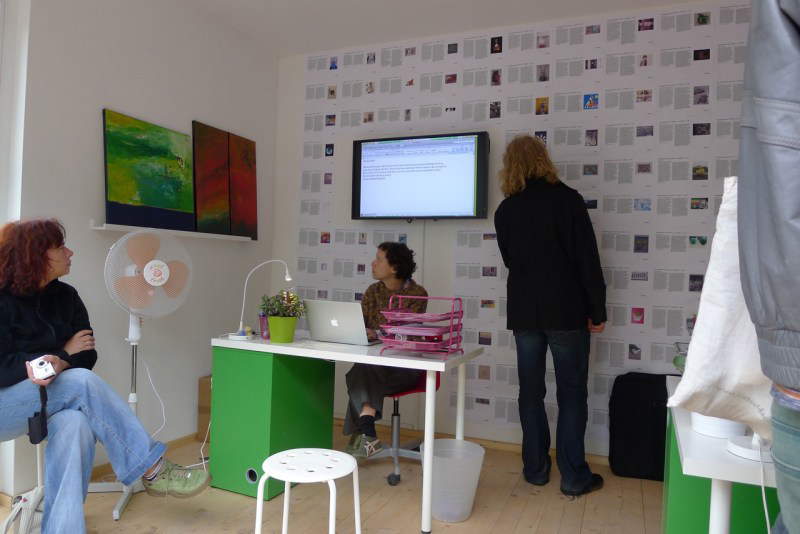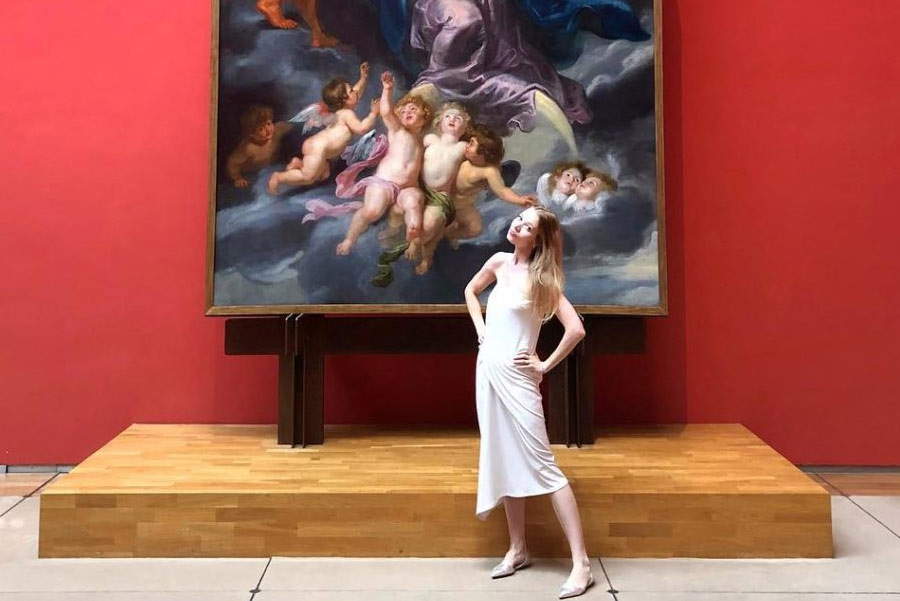Fifteen years have passed since Chicago Tribune art critic Lori Waxman began touring museums, galleries and various exhibition venues with her now-famous performance, 60 wrd/min art critic, whose mechanism is very simple: in the space chosen to host the action, an office is recreated, and she sits in front of a computer screen, receiving one at a time, as in a doctor’s or psychologist’s office, the artists who want to submit their work to her. Having finished listening to the artist and examining his or her work, Lori Waxman takes a few minutes to write an instant review, which is then put down on paper with a printer, and then hung on a bulletin board: the articles, arranged next to each other, end up composing a kind of art review produced in real time, over the duration of the individual performance.
There may be at least two good reasons for considering 60 wrd/min art critic a particularly brilliant work. On the one hand, at perhaps its most romantic and at the same time most didactic, the performance gives substance to the various stages of the art critic’s work: observing the works, talking to the artist, studying, thinking, writing, publishing (and the article does not necessarily have to be positive). On the other hand, one could read Lori Waxman’s work as an effective portrait of what has become, for many, the profession of art critic, or as a magnifying glass that slides over the problems that plague art criticism, forced at an ever-increasing pace (which inevitably affects the quality of content), to have to navigate among an enormous quantity of artists (perhaps never before has artistic production been so widespread as in this period of history), to confront the growing irrelevance to which many who profess this profession seem to be condemned (Jerry Saltz already said this in unsuspected times, and the facts have proved him right: thus, the figure of the critic has gradually been replaced by that of the curator who often does nothing more than write content on demand for artists, who are happy to spend lavish amounts of money on this activity because they know that they will be able to benefit from it for their exhibitions or their curricula).
 |
| Lori Waxman during her performance 60 wrd/min art critic |
While it is true that Lori Waxman, with her performance, in a sense chronicles, not without a certain irony, the crisis of art criticism, it is also true that the web, in this process, has not played such a decisive role: the crisis started before the web came to fundamentally change the way of doing art criticism, before social networks were even born (or, at least, before they became popular), and of course by far before new figures arose who, with greater or lesser merit, tell the story of art between the folds of the web. Perhaps Luca Beatrice is right when, in his latest article in Il Giornale, he writes that “no art critic or curator was born on the web,” but it is also certain that it is the same “traditional tools of knowledge” (in a word: the academy) that have played no small role in the crisis of art criticism. The “ghettoization” of criticism was already being talked about in the 1990s, we did not need Facebook or Instagram to mature the awareness of the fact that critics very often write for other critics, nor do we need to have read the Tribune ’s D’Annunzio to understand that many critics do not know how to capture the attention of those who read them, they express themselves with flatness and sloppiness, they ignore the use and importance of rhetorical figures, and all this does not depend on the web.
The web is a tool, it has become indispensable in an era of decline of traditional publishing (Luca Beatrice’s article itself, by the way, was published on the online version of the newspaper that first offered it in print format, and it will probably have reached a wider audience thanks to its being put online), it has expanded the possibilities to form, since a review by an important art historian or art critic has the same value whether it comes out in a print or an online journal (journalism laws equate paper titles with digital ones in every way, but the same reasoning applies to scholarly journals: I challenge anyone to prove that Memofonte Studies or Engramma are less valuable than other journals just because they are entirely published online), has made research easier (think of portals such as JSTOR or Academia). It is one thing, then, to talk about the web in a broad sense, and quite another to limit oneself to examining the figure of theinfluencer, who of the web is but one of its many inhabitants. He probably counts himself among the most noisy and à la page frequenters of the web, but that is not to muddy the waters, mixing in the same pot the activity of influencers and that of those who use the web for a thousand other purposes and supported by a thousand other reasons.
What then is theinfluencer? It should be emphasized that we are moving on smoky ground, since there are no established and unique definitions: according to a broader meaning, an influencer is anyone who contributes to creating opinion through a social network. Even Bonami, for instance, could be considered an influencer, since he uses Instagram with great ease and has a certain following: of course, there are no thresholds above which one is an influencer, nor is there anyone who certifies that someone who has reached a certain number of followers has entered the world of influencers, but it is nonetheless agreed that, in order to be considered as such, one needs to have followers in the thousands (and that they are natural, that is, real people who follow theinfluencer because they are genuinely interested in what he or she does or writes). Then there are those who understand the figure of theinfluencer more narrowly: the Cambridge Dictionary, for example, defines it as “a person paid by a company to show and describe its products on social media, encouraging other people to buy them.” In between are perhaps other figures (I think this is the case of our art influencers) who, to activities paid by museums or galleries eager to advertise themselves through their channels, alternate posts in which they provide advice dictated by their real interests, or simply like to show the public some moments of their daily life. This being the case, it no longer makes sense to ask whether theinfluencer is capable of “inventing Arte Povera or Transavantgarde and getting results from it in the marketplace”: if we consider anyone who makes an opinion to be an influencer, then he or she can easily invent a credible art movement that is destined to remain in art history regardless of his or her presence on social media. If, on the other hand,influencer is to be understood in the other sense, then ours probably won’t even be interested in becoming the new Celant or the new Bonito Oliva, because that is not his job.
 |
| Art influencer Elena Soboleva in front of Rubens’ Coronation of the Virgin at the Musées Royaux des Beaux-Arts in Brussels |
That then the world of influencers is governed by widespread superficiality, I think, is a fact on which, however, I think it is hardly worth dwelling: Massimiliano Parente talked about it at the beginning of the year, and again in the Giornale (which evidently, for some reason that frankly escapes me, has developed a certain idiosyncrasy toward influencers), in an article about book influencers, who are guilty of producing content that is empty, frivolous, and always the same (think of the ubiquitous colored placemat with book, croissant, and coffee cup, all shot from above: perhaps all book influencers read while having breakfast). We all agree that there is a section of the influencer world (perhaps they may be the majority, but at the moment I do not think I am in a position to compile a statistic) that debases and demeans the products that are being advocated (and perhaps often does not even know well the subject matter they are talking about): however, spilling ink on the book influencers who take the usual photograph of the latest bestseller next to a brioche with cappuccino, or on theart influencer who takes the usual selfie in front of a Klimt or Frida Kahlo painting (as if certain old school art critics were not equally exhibitionist: so many of them are equally vain, but they express themselves in other ways and through other channels), is a very easy exercise, one that perhaps pays off in the immediate term (there will always be a large audience applauding those who linger to berate influencers), but one that leaves little behind, because it adds little to the discussion (by now I think it is clear to everyone what the most common behaviors are among influencers: perhaps, however, the reasons that dictate their attitudes are less clear).
And so, for those who do critique or journalism with traditional tools, perhaps there is more merit in questioning not the critical velleities of influencers or their business models (which, moreover, seem clear enough to me), but the composition and expectations of their audiences (because it seems clear to me that, if influencers have such a large following, it is evidently because they are able to respond effectively to a demand that comes from below), on their relationship with those who provide them with content (if a museum or gallery decides to rely on an influencer it is because perhaps there is a very large portion of the public who, in order to inform themselves about what is happening in the art world, prefer to use social media), on why their modes of communication exert a certain attraction on many, on whether or not that perhaps part of the public may cultivate a certain curiosity about art, which traditional critics fail to satisfy and which, on the contrary, influencers are able to tickle. Beatrice, in her article, speculates that the figure of theart influencer is spreading “to combat the established elitism” of the “art world.” Faced with the “elitism of the art world,” I believe there are two options: take a reactionary attitude (entirely legitimate), but one that could perhaps lead us further down the path of irrelevance, or take note that the world and society have changed, that there is a growing demand for culture (I think the data on museum attendance are a good demonstration), that invective is perhaps not the most appropriate genre with which to respond to rampant superficiality, and that art communication cannot do without the Web.
Warning: the translation into English of the original Italian article was created using automatic tools. We undertake to review all articles, but we do not guarantee the total absence of inaccuracies in the translation due to the program. You can find the original by clicking on the ITA button. If you find any mistake,please contact us.